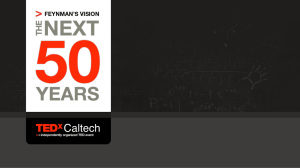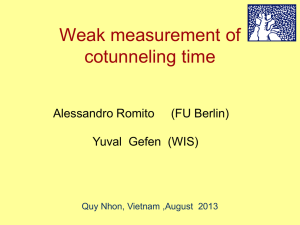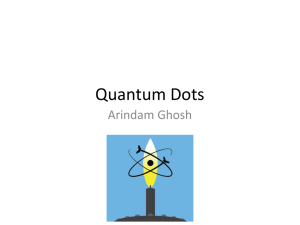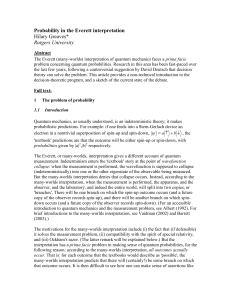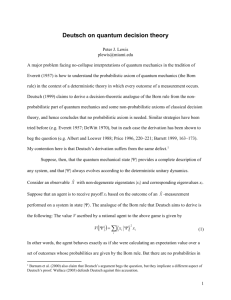Quantum Computing
advertisement
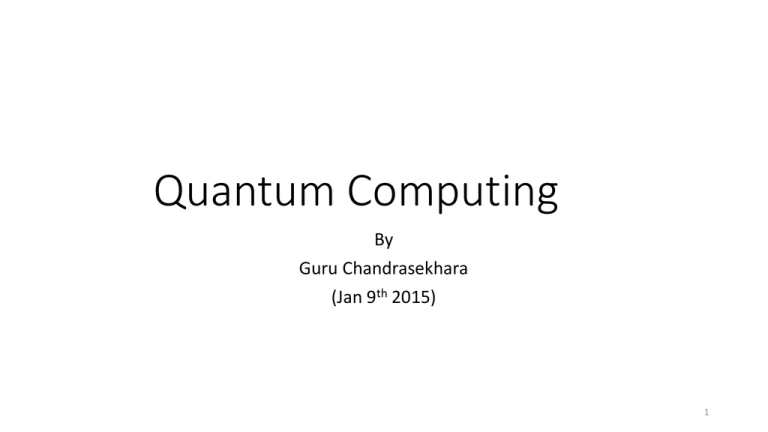
Quantum Computing By Guru Chandrasekhara (Jan 9th 2015) 1 Agenda • Introduction • History • Motivation • Basic concepts of quantum computer • Applications • Advantages and Disadvantages • Summary 2 Introduction • What is a quantum computer? A quantum computer is a machine that performs calculations based on the laws of quantum mechanics, which is the behavior of particles at the sub-atomic level. 3 History “I think I can safely say that nobody understands quantum mechanics” - Feynman 1982 - Feynman proposed the idea of creating machines based on the laws of quantum mechanics instead of the laws of classical physics. 1985 - David Deutsch developed the quantum turing machine, showing that quantum circuits are universal. 1994 - Peter Shor came up with a quantum algorithm to factor very large numbers in polynomial time. 1997 - Lov Grover develops a quantum search algorithm with O(√N) complexity Source: http://www.telegraph.co.uk/ 4 Why do we need quantum computer? Gordon Moore, Co-founder Intel Source: http://www3.pcmag.com/media/images/246128gordon-moore.jpg Source: http://tedxsydney.com/site/item.cfm?ite m=2B8FBE09C290F6C9771E4D98A24DC6 81 5 Motivation: Travelling Salesman Problem Older than universe 1600 years 100 sec 1 Ghz Computer: 14 Cities: 1011 routes 100 sec 22 Cities: 1019 routes 1600 years 28 Cities: ??? 6 Basic concepts : Qbits(1) • A classical computer performs operation using classical bits (0 & 1). • A Quantum computer performs operations using Quantum bits (Qbit). • Qbit is a unit of quantum information which can be 0 and 1 at the same time. • Many different objects can be used as quantum state (Photons, nucleus, electrons). 7 Basic concepts : Qbits(2) • An electron has dual nature: particle or wave. • Wave exhibits a phenomenon known as superposition of waves. Super position, 1 spin: |> = 1 |0> + 2 |1 No of Qbits Classical possibilities power 1 0 or 1 2 2 00, 01, 10, 11 4 3 000,…,111 8 2N N 30 Qbit More powerful than super computer 300 Qbit ? 8 Representation of Data - Qubits • A physical implementation of a qubit could use the two energy levels of an atom - excited state ( |1> ), ground state (|0>) Light pulse of frequency for time interval t Excited State Nucleus Electron State |0> State |1> 9 Applications • Factorization • True randomness • Quantum teleportation • Quantum networking • Encryption problem & quantum chemistry • Molecular simulations • Searching • Artificial intelligence 10 Advantages and Disadvantages • Advantages • Could process massive amount of complex data • Ability to solve scientific and commercial problems • Process data in much faster speed • Disadvantages: • Security and Privacy Issues • Ability to crack down passwords • Capability to break down every level of encryption • Not suitable for word processing and email. • Complex hardware 11 Summary • Quantum computer – A computer which works on the principles of quantum mechanics • End of Moore’s law • Advantages outweigh disadvantages – Factorization vs security • Wide range of applications 12 References • http://en.wikipedia.org/wiki/Quantum_computing • http://arxiv.org/pdf/quant-ph/9602014.pdf • https://www.youtube.com/watch?v=cugu4iW4W54 • https://www.youtube.com/watch?v=g_IaVepNDT4 13 14 BACK-UP 15 Deutsch’s Algorithm • • David Deutsch: famous British physicist Deutsch’s algorithm allows us to compute, in only one step, the value of f (0) f (1) • To do this classically, you would have to: 1. compute f(0) 2. compute f(1) 3. add the two results – Remember: f : 0,1 0,1 16 Circuit for Deutsch’s Algorithm 0 H 1 H x H x Uf 0 01 y 1 yf(x) 0 1 2 0 1 2 17 Circuit for Deutsch’s Algorithm (2) 0 H 1 H 2 x x H Uf y yf(x) 0 1 0 1 if f ( 0 ) f (1), 2 2 0 1 0 1 if f ( 0 ) f (1), 2 2 18 Circuit for Deutsch’s Algorithm (3) 0 H 1 H x x H Uf y yf(x) 0 1 if f (0) f (1), 0 2 3 if f (0) f (1), 1 0 1 2 ...and so we have computed this simplifies to 3 f (0) f (1) 0 1 2 f (0) f (1) 19




